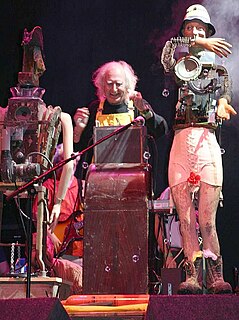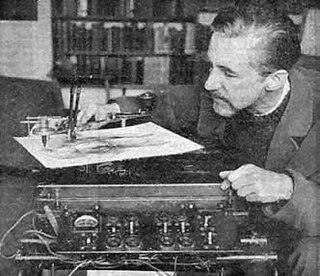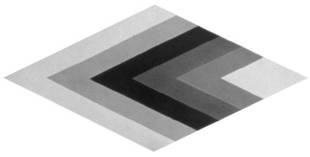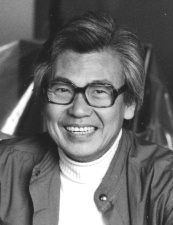Related Research Articles

Digital art refers to as any artistic work or practice that uses digital technology as part of the creative or presentation process, or more specifically as computational art that uses and engages with digital media.
Computer art is any art in which computers play a role in production or display of the artwork. Such art can be an image, sound, animation, video, CD-ROM, DVD-ROM, video game, website, algorithm, performance or gallery installation. Many traditional disciplines are now integrating digital technologies and, as a result, the lines between traditional works of art and new media works created using computers has been blurred. For instance, an artist may combine traditional painting with algorithm art and other digital techniques. As a result, defining computer art by its end product can thus be difficult. Computer art is bound to change over time since changes in technology and software directly affect what is possible.

Electronic art is a form of art that makes use of electronic media. More broadly, it refers to technology and/or electronic media. It is related to information art, new media art, video art, digital art, interactive art, internet art, and electronic music. It is considered an outgrowth of conceptual art and systems art.

Bruce Lacey was a British artist, performer and eccentric. After completing his national service in the Navy he became established on the avantgarde scene with his performance art and mechanical constructs. He has been closely associated with The Alberts performance group and The Goon Show. He made the props and had an acting part in Richard Lester's The Running Jumping & Standing Still Film.

Robotic art is any artwork that employs some form of robotic or automated technology. There are many branches of robotic art, one of which is robotic installation art, a type of installation art that is programmed to respond to viewer interactions, by means of computers, sensors and actuators. The future behavior of such installations can therefore be altered by input from either the artist or the participant, which differentiates these artworks from other types of kinetic art.

Vaughan Grylls is a British artist, photographer, and author. Known for his fine art photography and sculptures, Grylls first received recognition for his 1960s pun-sculptures and, later, for his 1980s photography and panoramic photo collages.
The Computer Arts Society (CAS) was founded in 1968, in order to encourage the creative use of computers in the arts.
Edward Ihnatowicz was a Polish cybernetic art sculptor active in the late 1960s and early 1970s. His sculptures explored the interaction between his robotic works and the audience.

Virtual art is a term for the virtualization of art, made with the technical media developed at the end of the 1980s. These include human-machine interfaces such as visualization casks, stereoscopic spectacles and screens, digital painting and sculpture, generators of three-dimensional sound, data gloves, data clothes, position sensors, tactile and power feed-back systems, etc. As virtual art covers such a wide array of mediums it is a catch-all term for specific focuses within it. Much contemporary art has become, in Frank Popper's terms, virtualized.

Desmond Paul Henry (1921–2004) was a Manchester University Lecturer and Reader in Philosophy (1949–82). He was one of the first British artists to experiment with machine-generated visual effects at the time of the emerging global computer art movement of the 1960s. During this period, Henry constructed a succession of three electro-mechanical drawing machines from modified bombsight analogue computers which were employed in World War II bombers to calculate the accurate release of bombs onto their targets. Henry's machine-generated effects resemble complex versions of the abstract, curvilinear graphics which accompany Microsoft's Windows Media Player. Henry's machine-generated effects may therefore also be said to represent early examples of computer graphics: "the making of line drawings with the aid of computers and drawing machines".

Golan Levin is an American new media artist, composer, performer and engineer interested in developing artifacts and events which explore supple new modes of reactive expression.

Systems art is art influenced by cybernetics, and systems theory, that reflects on natural systems, social systems and social signs of the art world itself.
Cybernetic Serendipity was an exhibition of cybernetic art curated by Jasia Reichardt, shown at the Institute of Contemporary Arts, London, England, from 2 August to 20 October 1968, and then toured across the United States. Two stops in the United States were the Corcoran Annex, Washington, D.C., from 16 July to 31 August 1969, and the newly opened Exploratorium in San Francisco, from 1 November to 18 December 1969.
Jasia Reichardt is a British art critic, curator, art gallery director, teacher and prolific writer, specialist in the emergence of computer art. In 1968 she was curator of the landmark Cybernetic Serendipity exhibition at London's Institute of Contemporary Arts. She is generally known for her work on experimental art. After the deaths of Franciszka and Stefan Themerson she catalogued their archive and looks after their legacy.

Cybernetics is a wide-ranging field concerned with regulatory and purposive systems. The core concept of cybernetics is circular causality or feedback—where the observed outcomes of actions are taken as inputs for further action in ways that support the pursuit and maintenance of particular conditions, or their disruption. Cybernetics is named after an example of circular causality, that of steering a ship, where the helmsperson maintains a steady course in a changing environment by adjusting their steering in continual response to the effect it is observed as having. Other examples of circular causal feedback include: technological devices such as thermostats ; biological examples such as the coordination of volitional movement through the nervous system; and processes of social interaction such as conversation. Cybernetics is concerned with feedback processes such as steering however they are embodied, including in ecological, technological, biological, cognitive, and social systems, and in the context of practical activities such as designing, learning, managing, conversation, and the practice of cybernetics itself. Cybernetics' transdisciplinary and "antidisciplinary" character has meant that it intersects with a number of other fields, leading to it having both wide influence and diverse interpretations.

Keith Albarn is an English artist. He is the father of musician Damon Albarn and artist Jessica Albarn.
Nouvelle Tendance was an art movement founded in Yugoslavia in 1961. The "theoretician" of the group was Croatian art critic Matko Meštrović. The other original founders of Nouvelle Tendance were Brazilian painter Almir Mavignier, and Božo Bek, the Croatian director of the Museum of Contemporary Art, Zagreb.

Wen-Ying Tsai was a Chinese-American pioneer cybernetic sculptor and kinetic artist best known for creating sculptures using electric motors, stainless steel rods, stroboscopic light, and audio feedback control. As one of the first Chinese-born artists to achieve international recognition in the 1960s, Tsai was an inspiration to generations of Chinese artists around the world.
Cybernetic art is contemporary art that builds upon the legacy of cybernetics, where feedback involved in the work takes precedence over traditional aesthetic and material concerns. The relationship between cybernetics and art can be summarised in three ways: cybernetics can be used to study art, to create works of art or may itself be regarded as an art form in its own right.
White Heat Cold Logic (2008), edited by Paul Brown, Charlie Gere, Nicholas Lambert, and Catherine Mason, is a book about the history of British computer art during 1960–1980.
References
- ↑ Benthall, Jonathan (1972). Science and Technology in Art Today. London: Thames and Hudson.
- ↑ Reichardt, Jasia (1978). Robots: Fact, Fiction + Prediction. Thames and Hudson. ISBN 0-500-27123-2.
- ↑ Simons, Geoff (1983). Are Computers Alive?. Brighton: Harvester. ISBN 0-7108-0501-2.
- ↑ Michie, Donald; Rory Johnston (1984). The Creative Computer: Machine Intelligence and Human Knowledge. Penguin Books. ISBN 0-670-80060-0.
- ↑ Kac, Eduardo (1997). "Origin and Development of Robotic Art". Art Journal. 56 (3): 60–67. doi:10.2307/777824. JSTOR 777824.
- ↑ Zivanovic, Aleksandar (April 12–15, 2005). "The Development of a Cybernetic Sculptor: Edward Ihnatowicz and The Senster". Creativity and Cognition Conference. pp. 586–591.
- ↑ Zivanovic, Aleksandar (April 13, 2005). "SAM, The Senster and The Bandit: Early Cybernetic Sculptures by Edward Ihnatowicz". Robotics, Mechatronics and Animatronics in the Creative and Entertainment Industries and Arts Symposium, AISB 2005 Convention. Hatfield, UK.
- ↑ Reichardt, Jasia (May 4, 1972). "Art at large". New Scientist.
- ↑ "Interactive sculpture SENSTER reactivated after more than forty years". www.agh.edu.pl. Retrieved 2019-08-17.